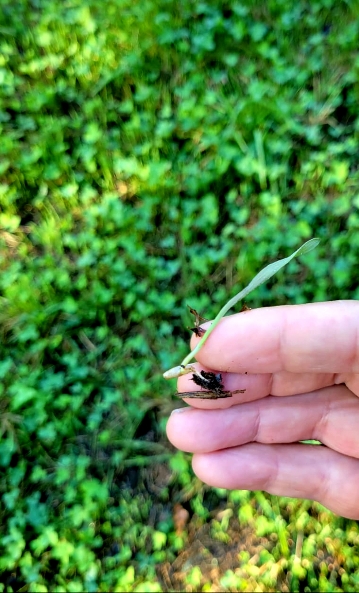"Dual System of Perennial Clover and Cereal Grain"
A perfect deer food plot needs to check a lot of boxes:
#1 Feeds deer year round
#2 Species has the ability to outgrow deer grazing pressure in small plots
#3 Grows in poor, low PH soil without a lot of soil amendments
#4 Can be managed without a lot of big equipment
#5 Is relatively inexpensive
#6 Doesn't require a lot of days of time specific maintenance throughout the year
#7 Seed is readily available
#8 Weeds are easily managed
#9 provides fawning cover
#10 Provides food for other desirable game species, but doesn't attract predators
#11 Unlike a monoculture, system keeps nitrogen and carbon balanced in the soil
#12 Not a lot of hours per year to manage an acre plot
So, this
"Dual System of Perennial Clover and Cereal Grain" that I have been using for many years is my number one all-time favorite, because it checks every last one of the above boxes. But right up front I also want to mention, we are located in the Mid-Atlantic region;
#1 The biggest downside is that this is a cool climate planting that performs the best somewhere around zone 6, and will probably not work well in the south.
#2 A lot of areas further west have longer dry spells in the summer, this system needs periodic rains to thrive.
Equipment requirements, in order of importance:
Seed broadcaster
Mower
Sprayer
Disc (just to do initial clover seeding)
Wire Drag Harrow (Tractor Supply )
To get started, a stand of clover needs to be established, my preferred choice is Ladino, however, a mixture of other perennial clovers works too. For grain in our zone 6B I prefer rye, as rye outperforms winter wheat at the edge of the snow belt.
Rye and clover are two species that are almost like weeds, requiring much less PH and fertilizer than most other species, but for best results get the soil nutrients up to spec using a soil test. I like to start by tilling and prepping the soil in spring or fall, then broadcasting ladino clover with a nurse crop, buckwheat, oats or barley in early spring, wheat or rye in early fall, rolling the soil after broadcasting. Once the clover has been established, the keys to this system are broadcasting 200 lb per acre of cereal rye into the clover around Labor Day, then mowing the clover at at mid height or slightly lower right after broadcasting the seed. Dragging a wire "drag harrow" through the plot with an ATV etc. right after mowing also increases germination rates substantially by scarifying the thatch and shaking down the seed to the soil, but this is not a must. The rye should be 4-8 inches tall before first frost.
As the clover freezes out in late fall the rye keeps growing, feeding deer most of the winter, a time when they really need food, especially something green when everything else is brown. It's often only an inch tall, or less, but keeps drawing the deer to the plot, and rye can grow in as cold as 39 degrees on southern exposures when the sun shines.
In early spring the rye thrives as other growth struggles to get started, and deer will stay zoned in on the plot, even after other growth becomes available.
After the rye becomes tall, tough, and unpalatable, the deer are often still in the plot eating the clover below the rye. As the rye gets taller, going into tube stage, it now becomes prime fawning cover. Mowing at this stage is a mistake that will result in dead fawns, the rye should be allowed to ripen, and the grain will feed the birds. Deer will also sometimes eat the rye grain, although it's not a preferred food.
The yellow straw then starts to collapse, at this point it can be mowed or just let to expire. This is also the stage to spray the clover with Butyrac200, Clethodim, Imazethapyr, or Imox for grass control. Rye is allopathic, and usually controls the early spring grass species on its own, but different grasses like cattails can become a problem in late summer without spraying.
Next, anytime in a time window of within 2 weeks of Labor Day, the entire cycle begins again.
One of the biggest side benefits of these two species is that clover raises nitrogen and feeds on carbon, while rye raises carbon, and feeds on nitrogen, therefore, the two balance nitrogen and carbon in the soil.
Optional;
Chicory with clover.
Brassicas with rye (keep to a minimum or they will compete with the rye but not feed deer in March)
The hardest parts for beginners, in order of difficulty;
#1 Establishing a good stand of Ladino Clover (use name brand coated seed) (Establishing clover requires bare dirt and a nurse crop)
#2 Controlling grasses in late summer (grasses are always at war with clover).
#3 Broadcasting Rye into clover: getting sunshine to seed by mowing, and, getting seed to soil contact in heavy thatch conditions, or the seed will not germinate.
Here is a picture of the
"Dual System of Perennial Clover and Cereal Grain" plot at 14 days:







